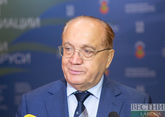2018 in Azerbaijan was declared the Year of the Azerbaijan Democratic Republic (ADR), in connection with which international conferences, exhibitions are held and books are published. The first major event outside of Azerbaijan dedicated to the centenary of the ADR was held at the History Faculty of the Moscow State University. It was a scientific and practical plenary session titled 'Russian Revolution and History of the Azerbaijan Democratic Republic: a look back a century later', whose participants discussed, in particular, the influence of the Russian Revolution on the development of Azerbaijani culture.
Associate professor of the Department of History of the CIS countries of the Faculty of History of the Moscow State University Perikhanum Ragimova, speaking about the activities of the ADR aimed at the revival of the Azerbaijani statehood, said: "To realize the task, it was necessary to form a new generation in the spirit of preservation or development of national identity. Realization of all these tasks required the educational reform. All schools on the territory of Azerbaijan were nationalized. Nationalization included the introduction of the Azerbaijani language in national schools. Nevertheless, there were Russian schools, Armenian schools, and German schools on the territory of the ADR. They received the same attention, they were funded by the Azerbaijani government. But they had funding and staff problems. In a relatively short period, universities were opened, the Azerbaijani government adopted a resolution on the opening of the Pedagogical University, on the opening of the Baku University."
Along with the changes in the sphere of education, there have been changes in the sphere of culture. "The repertoire of the Azerbaijani theaters has been changed, which was aimed at reviving the Azerbaijani identity. The troupes were created in the theaters, which consisted only of Muslims. The ADR existed until April 1920, but in a short period of its existence it was not directed towards nationalism, as in addition to the national Azerbaijani schools there were schools of national minorities in Azerbaijan, teaching in which was conducted in the Turkic as the language of instruction," the historian noted.
Meanwhile, according to Ragimova, when the Soviet power was established on the territory of Azerbaijan, the language policy was changed, Russian as the language of instruction was introduced in schools.
Later, the development of Azerbaijani culture continued - in the 1940s the film 'Arshin Mal Alan' was released, and in the 1970s and 1980s there was a rise of Azerbaijani cinema. Polad Bulbul oglu and Muslim Magomayev became widely known. "Magomayev made a great contribution to the development of the musical art of both Soviet Azerbaijan and post-Soviet Azerbaijan. Therefore, he was extremely popular. His first performance in Moscow was in 1963. He treated his country with piety," Ragimova said.
Soviet power, despite the excesses in the sphere of national policy, leveling of linguistic and national borders, had provided valuable inputs to Azerbaijan's humanitarian sphere. "A lot of attention was paid to science as well. In 1934, a branch of the Academy of Sciences was opened in Azerbaijan. Literacy was raised, universities were built, theaters were opened," the historian said.










